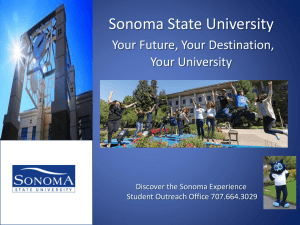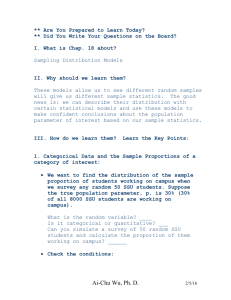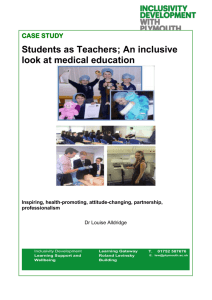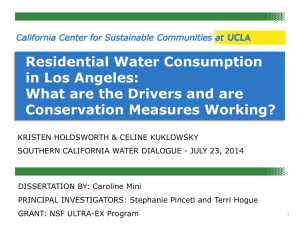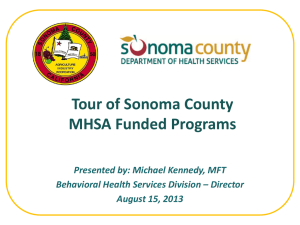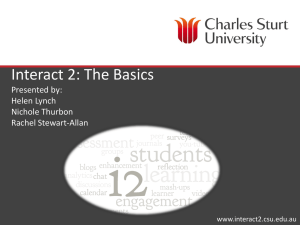Core Academic Priorities Require University
advertisement
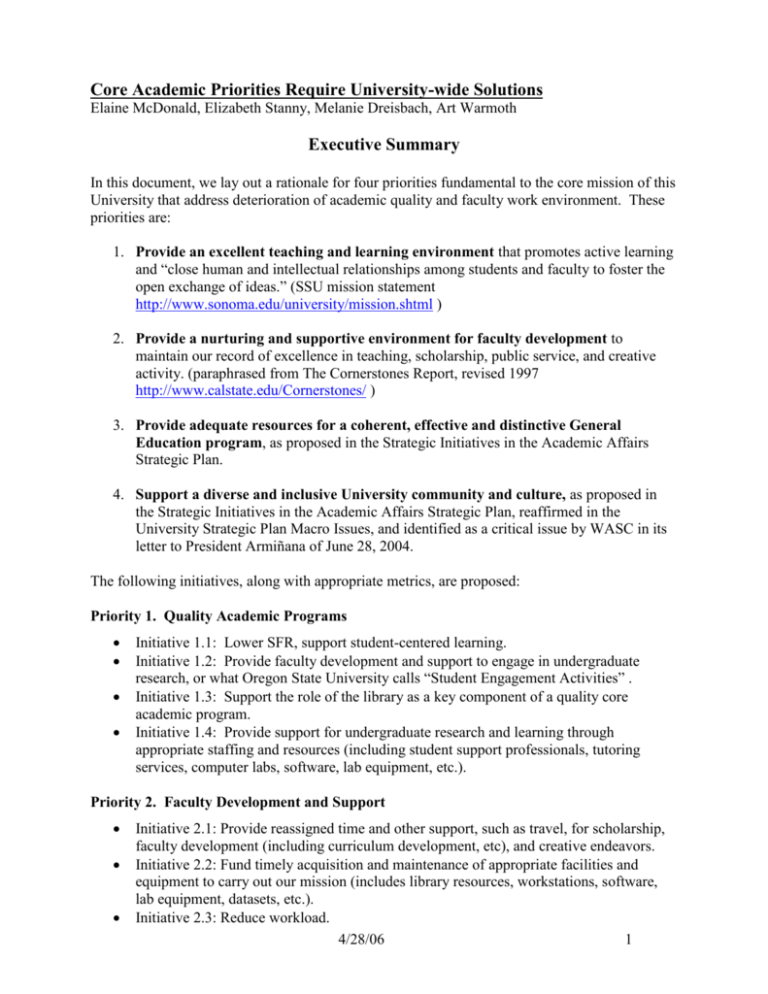
Core Academic Priorities Require University-wide Solutions Elaine McDonald, Elizabeth Stanny, Melanie Dreisbach, Art Warmoth Executive Summary In this document, we lay out a rationale for four priorities fundamental to the core mission of this University that address deterioration of academic quality and faculty work environment. These priorities are: 1. Provide an excellent teaching and learning environment that promotes active learning and “close human and intellectual relationships among students and faculty to foster the open exchange of ideas.” (SSU mission statement http://www.sonoma.edu/university/mission.shtml ) 2. Provide a nurturing and supportive environment for faculty development to maintain our record of excellence in teaching, scholarship, public service, and creative activity. (paraphrased from The Cornerstones Report, revised 1997 http://www.calstate.edu/Cornerstones/ ) 3. Provide adequate resources for a coherent, effective and distinctive General Education program, as proposed in the Strategic Initiatives in the Academic Affairs Strategic Plan. 4. Support a diverse and inclusive University community and culture, as proposed in the Strategic Initiatives in the Academic Affairs Strategic Plan, reaffirmed in the University Strategic Plan Macro Issues, and identified as a critical issue by WASC in its letter to President Armiñana of June 28, 2004. The following initiatives, along with appropriate metrics, are proposed: Priority 1. Quality Academic Programs Initiative 1.1: Lower SFR, support student-centered learning. Initiative 1.2: Provide faculty development and support to engage in undergraduate research, or what Oregon State University calls “Student Engagement Activities” . Initiative 1.3: Support the role of the library as a key component of a quality core academic program. Initiative 1.4: Provide support for undergraduate research and learning through appropriate staffing and resources (including student support professionals, tutoring services, computer labs, software, lab equipment, etc.). Priority 2. Faculty Development and Support Initiative 2.1: Provide reassigned time and other support, such as travel, for scholarship, faculty development (including curriculum development, etc), and creative endeavors. Initiative 2.2: Fund timely acquisition and maintenance of appropriate facilities and equipment to carry out our mission (includes library resources, workstations, software, lab equipment, datasets, etc.). Initiative 2.3: Reduce workload. 4/28/06 1 Priority 3. General Education Initiative 3.1: Develop a model for assessing the goals and objectives of the Statement on the Mission, Goals and Objectives of General Education adopted by the Senate that could be applied to the existing, as well as any revised, GE curriculum. Initiative 3.2: Develop a plan that identifies the resources that can be dedicated to the assessment and planning of GE curriculum, as well as to improving the effectiveness of GE curriculum. Priority 4. Improve the Climate for Diversity Initiative 4.1. Work together as a community to clarify what SSUs optimal diversity profile should be, and whether we should reach for representation comparable to our service area, the North Bay region, or the state. Initiative 4.2. Provide a support structure and training program designed to increase retention rates of a diverse community. 4/28/06 2 Core Academic Priorities Require University-wide Solutions Elaine McDonald, Elizabeth Stanny, Melanie Dreisbach, Art Warmoth With the arrival of a new Provost, a visible culture of planning has re-emerged at Sonoma State involving all areas of administration, faculty, staff, and students. After years of severe budget cuts, the Division of Academic Affairs has been stripped of the means to accomplish much beyond presenting the bare courses that students need to graduate. Courses have been cut, SFR has soared, faculty and staff workload has increased, while salaries have lagged behind comparable institutions. Reassigned time and other support for scholarly and creative activities have been cut, and programs to refresh workstations, update critical software, equip labs, and purchase needed datasets have been frozen. At the same time, the pressure has increased for faculty to increase scholarship, to foster an active learning environment for our students, to compete for grants, and to engage in quantitative program assessment. In this document, we lay out a rationale for four priorities fundamental to the core mission of this University that address deterioration of academic quality and faculty work environment. These priorities are: 1. Provide an excellent teaching and learning environment that promotes active learning and “close human and intellectual relationships among students and faculty to foster the open exchange of ideas.” (SSU mission statement http://www.sonoma.edu/university/mission.shtml ) 2. Provide a nurturing and supportive environment for faculty development to maintain our record of excellence in teaching, scholarship, public service, and creative activity. (paraphrased from The Cornerstones Report, revised 1997 http://www.calstate.edu/Cornerstones/ ) 3. Provide adequate resources for a coherent, effective and distinctive General Education Program, as proposed in the Strategic Initiatives in the Academic Affairs Strategic Plan. 4. Support a diverse and inclusive University community and culture, as proposed in the Strategic Initiatives in the Academic Affairs Strategic Plan, reaffirmed in the University Strategic Plan macro Issues, and identified as a critical issue by WASC in its letter to President Armiñana of June 28, 2004, As these priorities are core to our mission and the mission of the CSU, we believe the entire University needs to embrace these priorities and to direct resources towards these priorities. We suggest metrics that quantitatively measure progress towards addressing these priorities. Priority 1. Quality Academic Programs The Academic Affairs Division Draft Strategic Plan states that the mission of Academic Affairs is to “promote excellence in teaching and learning, inquiry, and service.” Further, “[t]o advance its mission, Academic Affairs encourages interactive teaching and learning and close mentoring relationships.” (AA Draft Strategic Plan, 2005) Cornerstones supports this approach to teaching excellence. Principle 3 in the plan states that “Students will be expected to be active partners 4/28/06 3 with faculty in the learning process, and the University will provide opportunities for active learning throughout the curriculum.” Initiative 1.1: Lower SFR, support student-centered learning Unfortunately, the latest data on SFR (Fall 2004) indicate that Fall 2004 SFR was 24.7:1. From 1989 to 2004, SSU’s SFR has increased from 18.3:1 to 24.7:1. As of Fall 2004, SSU had the second highest SFR in the CSU system. During this same period, our FTES increased by 27% and FTEF fell by 5%. In light of increasing FTES and decreasing FTEF, SSU faculty’s ability to deliver a quality student-centered, interactive education has been compromised. Current research supports the assertion that smaller classes positively affect student learning and retention. In the metaanalysis The Empirical Case Against Large Class Size, Joe Cuseo documents eight “deleterious outcomes associated with large-sized classes.” Among them he finds that large classes reduce active involvement by students, reduce instructor interaction and feedback, reduce over-all learning, and reduce students’ satisfaction with the course. Cuseo links these effects to the low national freshman-to-sophomore retention rates. Some support for low SFR pedagogy can be generated using innovative pedagogies that have been developed for teaching large classes. A comprehensive look at managing class sizes can be found in the 2005 Report of the Joint EPC-APC Task Force on Large Enrollment Classes (Professor Art Warmoth et al.). However, there is also a growing nationwide interest among educational leaders in community-based and learner-centered “student engagement activities.” (See Initiative 1.2 below.) When these activities are offered, they generate student demand. The net effect of the need for these low SFR modes of instruction is likely to offset the effects of increasing the number of large SFR classes. The faculty should engage in a reassessment of the pedagogical mix that is appropriate for an excellent midsize liberal arts and sciences university, but in the meantime a target nearer the CSU system median seems appropriate and consistent with our membership in COPLAC. The SSU Senate Academic Planning Committee recommends a target SFR of 20:1. In addition, moving toward a lower SFR and student centered learning requires the University to insure adequate FTEF to maintain the integrity of existing majors and programs across all disciplines. Initiative 1.2: Provide faculty development and support to engage in undergraduate research, or what Oregon State University calls “Student Engagement Activities” The Cornerstones Implementation Plan for Principle 3 makes it a campus priority to “expand student involvement in scholarship, research, and creative activity under faculty guidance, because these activities are central to the teaching and learning mission of a comprehensive university.” Developing and participating in active learning experiences for students requires time and University support, including a reasonable compensation of WTUs to faculty. The Cornerstones Implementation Plan for Principle 3 also makes it a campus priority to “facilitate such practices of active learning.” As an example of an institutional response to such a priority, Washington State University, in its 2003-2004 Strategic Plan Implementation Progress Report, “establish[s] a broad-based advisory board for undergraduate research” that would 4/28/06 4 coordinate and promote undergraduate research across campus and “identify funding opportunities to support undergraduate research.” Not only do faculty need the operational and organizational support of the administration to increase student engagement outside the classroom, faculty need to be compensated for the intense work required to guide and support student research. Currently the 1/3 WTU per student awarded for undergraduate supervision means faculty essentially involve students in research for free. A program that allows faculty to participate in directed student research with 3 or 4 students for a one course release would more adequately compensate the faculty member, making an undergraduate research program feasible. Initiative 1.3: Support the role of the library as a key component of a quality core academic program. In order to strengthen undergraduate learning, research and to prepare students for a "working world" that the Cornerstones Plan for Implementation in Principle 1 correctly identifies as "requiring uncommon adaptability to changing circumstances," the University needs to recognize and support efforts and resources not tied to FTE-based instruction, such as the University Library. Priority 4 of the Academic Affairs Strategic Plan, recognizes the importance of information competence skills to the success of students as life-long learners, and the library provides strong leadership for the infusion of these skills into the curriculum by supporting both students and faculty. Initiative 1.4: Provide support for undergraduate research and learning through appropriate staffing and resources (including student support professionals, tutoring services, computer labs, software, lab equipment, etc.) Principle 2 of the Cornerstones Plan that clearly states, "Every member of the university community – faculty, staff, administration, and students themselves – has a responsibility to help students succeed." Areas not tied to direct instruction but necessary to students' success, engagement, active learning and future "adaptability" include staffing of student support professionals, the writing center and other tutoring services, and support of educational technology staff and equipment, which benefits both faculty and student projects. Metrics associated with Priority 1. First Year Retention Rate 6-year Graduation Rate Post-graduate Satisfaction Student to Faculty Ratio Percent of Students Participating in Student Engagement Activities (broadly defined and includes internships, service learning, undergraduate research) Full Time Equivalent Faculty LibQual+ Survey (Survey solicits, tracks, understands, and acts upon users’ opinions of library service quality. For more information see http://www.libqual.org/ ) 4/28/06 5 Priority 2. Faculty Development and Support The Cornerstones Report’s Principle 4 states that “The CSU will reinvest in its faculty to maintain its primary mission as a teaching-centered comprehensive university. Faculty scholarship, research, and creative activity are essential components of that mission.” The mission of the CSU states that the system will provide “an environment in which scholarship, research, creative, artistic, and professional activity are valued and supported.” Additionally, the draft Academic Affairs Strategic Plan’s first General Strategy is to “Attract, retain and support excellent faculty and staff.” Unfortunately, Sonoma County has an extremely high cost of living, and faculty salaries are low, even relative to the CSU system (see Moulton, 2005 and McKillop for more analysis). However, by addressing Priority 2, we can improve the quality of work-life for faculty and continue to recruit highly qualified new faculty. Furthermore, investment in faculty development, including faculty involvement in curriculum development and curriculum-oriented action research, is essential to virtually all of the Strategic Initiatives identified in the draft Academic Affairs Strategic Plan. Three of the Strategic Initiatives are: to enhance teaching and learning by information competence into the curriculum and increasing information access via the library and instructional technology; to build relationships with the community to serve regional needs and enhance or student’s learning; and to continually assess and improve academic programs and curriculum. Investment in faculty development is also critical to achieving the priorities identified by WASC such as in the areas of assessment of educational effectiveness, improving the climate for diversity (see priority 4), and General Education and the “Marks” of the SSU student experience (see priority 3). Initiative 2.1: Provide reassigned time and other support, such as travel, for scholarship, faculty development (including curriculum development, etc), and creative endeavors. The Implementation Plan for Cornerstone’s Principle 4 states in part that “each University will support research, scholarly, and creative activities for the faculty as a central element of a rich learning environment for our students.” In addition, “each University will provide a more coordinated and substantive faculty development effort. These efforts will be supported by seeking new resources and by recognition of faculty time needed for these purposes.” Perhaps the resource most needed to pursue scholarly activities is time. Faculty however, also benefit from faculty writing groups, the Center for Teaching and Professional Development, and other peer-to-peer support and development programs that enhance curriculum development, grants and contract writing, etc. Initiative 2.2: Fund timely acquisition and maintenance of appropriate facilities and equipment to carry out our mission (includes library resources, workstations, software, lab equipment, datasets, etc.) The lack of a workstation refresh program is perhaps the most visible of equipment and technology problems facing faculty and staff on this campus. Faculty computers are aging to 4/28/06 6 such an extent that IT refuses to support the machines and software on them. IT is threatening to block any computers from the SSU network that don’t have appropriate security in place. In addition, since the loss in the early 90s of a regular and substantial instructional equipment budget for the Schools, faculty have struggled to maintain other technology and equipment needed for research and teaching. For example, Mathematics faculty have been unable to fund updated instructional software in statistics. Faculty in Political Science have been unable to purchase critical datasets. These are only a few examples. A targeted funding pool is needed, or department OE money needs to be expanded, to allow faculty to acquire and maintain appropriate technology and information for changing research and instructional needs. IT support for instructional technology needs to be expanded. Initiative 2.3: Reduce workload. Workload is a major issue for faculty and staff at SSU. The Cornerstones Implementation Plan required the system to “respond to faculty concerns about heavy teaching and other responsibilities with a nationally-based comparative study.” A 2001 study by the Social and Behavioral Research Institute at CSU San Marcos for the CSU, the Comparable Faculty Workload Report, found that faculty workweek had increased from 48.5 hours to 50.2 between 1990 and 2001 (full report cited below), with the largest percentage increases in time spent on scholarly activities and time spent in administrative activities. Increased workload and the increase in SFR point to the need to hire adequate faculty to support existing programs and respond to the anticipated growth in FTES. Reducing SFR and increasing compensation for other teaching related and scholarly activities is critical to retaining qualified faculty and increasing the satisfaction of our students. Metrics associated with Priority 2. Percentage reassigned time for faculty scholarship and professional activities, including undergraduate research Travel money funding pool Percentage faculty workstations replaced Equipment money funding pool for faculty research Faculty start-up funding pool Number of faculty supported by a subsidized University housing program Priority 3. General Education Cornerstones mandates that “each university will have a faculty determined comprehensive set of general education outcomes that are sufficiently specific to support a public declaration of educational results, and sufficiently general to allow each college and department to develop its own educational outcomes.” One of the Academic Affairs Strategic Plan strategic initiatives is to “build a coherent, effective and distinctive General Education Program.” In the letter to President Armiñana of June 24, 2004, WASC identified “General Education and the ‘Mark’ of the SSU Student Experience” as an area where improvement is needed. 4/28/06 7 On March 3, 2003 the Academic Senate adopted a Statement on the Mission, Goals & 0bjectives of General Education at Sonoma State University. In May 2004, the Senate charged EPC and GE to develop a GE reform proposal. A joint EPC/GE Task Force on General Education was formed and submitted a report outlining A New Path for General Education at Sonoma State. Subsequently, a Task Force under the direction of the GE Subcommittee has been working on a pilot project for a Freshman Year Experience that would implement some aspects of the New Path, including providing data on the effectiveness of some of the innovative pedagogies proposed. The goal is implementation for the 06-07 academic year. However, resources have yet to be identified for scaling up the Freshman Year Experience, should the results of the pilot project so warrant. In order to move forward with the further development of a revised General Education curriculum, the University needs a comprehensive assessment model and an investment of resources in the planning process, including curriculum and faculty development. Additionally, resources will need to be invested in order to lower the SFR for lower division courses as well as in all courses. Initiative 3.1: Develop a model for assessing the goals and objectives of the Statement on the Mission, Goals and Objectives of General Education adopted by the Senate that could be applied to the existing, as well as any revised, GE curriculum. WASC’s concern appears to be primarily with the area of assessment. Many faculty have expressed a need for a more carefully crafted assessment of the educational outcomes of the GE experience, including a systematic survey of faculty teaching GE courses. The development of appropriate assessment methodology for the assessment of outcomes is primarily under the jurisdiction of EPC and the GE Subcommittee. This is a complex task that will require the allocation of adequate resources. Initiative 3.2: Develop a plan that identifies the resources that can be dedicated to the assessment and planning of GE curriculum, as well as to improving the effectiveness of GE curriculum. Review and improvement of the GE curriculum is an area where the alignment of institutional priorities with mission is of fundamental importance. Alignment of priorities implies identifying specific and sufficient resources that can be committed to this activity. Metrics associated with Priority 3. Lower Division Student Faculty Ratio Assigned time per semester for coordination of assessment and curriculum development Priority 4. Improve the Climate for Diversity Sonoma State’s Diversity Vision Statement declares that, “[W]e stand committed to fostering and sustaining a pluralistic, inclusive environment that empowers all members of the campus community to achieve their highest potential without fear of prejudice or discrimination.” The notable lack of diversity on campus was identified as a concern by WASC, and it has been included in every planning document originating on campus. It is widely recognized as an important component of the mission of the CSU, as well as of Sonoma State. 4/28/06 8 The problem has been the allocation of sufficient resources to bring this institutional priority into effective alignment with our stated mission. Resources must be invested in at least two areas: recruitment of a diverse community of students, faculty, and staff, and development of support and training programs to improve retention of the students, faculty and staff we recruit. In addition to cultural diversity, gender identity, disability status, income status and age should be considered as relevant diversity categories. Initiative 4.1. Work together as a community to clarify what SSUs optimal diversity profile should be, and whether we should reach for representation comparable to our service area, the North Bay region, or the state. Demographics are an important indicator of effective diversity. While the optimal diversity goal might be approximating the diversity of the State of California, a more realistic medium-term goal would be to achieve diversity representative of our North Bay service area. Faculty, administration, and student groups need to work together to clarify what SSUs optimal diversity profile should be. Achieving representative diversity will require investment in both recruitment and student support. Existing groups representing diversity students, such as MEChA and the Black Student Union, should be consulted and utilized as planning resources. Initiative 4.2. Provide a support structure and training program designed to increase retention rates of a diverse community. Once we recruit a diverse student, faculty, and staff community, we must have in place systems to retain them. For students, this may mean increasing available financial aid to include special needs-based scholarships. The campus should establish more formal mentoring programs for students, faculty and staff, at least partly utilizing existing groups. Diversity workshops and trainings have been conducted at various times by outside consultants. While the need to use outside consultants will remain, if Sonoma State is serious about increasing effective diversity, the educational expertise to make that happen should reside on campus, and faculty should be actively involved. It is important to recognize that cultural competence involves interpersonal communication and relationship-building skills as well as research and theory. Ultimately, it would be important to include cultural competence in the curriculum, both in courses dedicated to the topic as a component of other classes. It would also be desirable for Sonoma State to be recognized as a major resource in this area for the community at-large. Metrics associated with Priority 4. Student, faculty, and staff demographics in comparison with regional demographics Retention rates of students, faculty, and staff in various diversity categories Amount of financial aid and needs-based scholarships Number of workshops or other opportunities for professional education in cultural competence 4/28/06 9 Conclusions Listing priorities is the first step. Next, we must set targets that enable us to address our priorities, estimate costs to achieve these targets, and identify resources to fund the costs. Ohio State University and Fort Lewis Colleges provide resource plans that might help us develop our own (see: http://www.osu.edu/academicplan/resources.php or Fort Lewis Colleges’ Plan for Action distributed at the Convocation). The importance of aligning resources with mission is important to all the university stakeholders and to WASC. In addition, pressure from the CSU to facilitate graduation (22 Points for Facilitating Graduation, memo from Chancellor Reed to CSU Presidents, 2005) requires the Presidents to “provide appropriate funding, support.” Current research in higher education supports the idea that increased spending on direct instruction such as providing resources to address Priorities 1 and 2 will increase graduation rates. A 2005 article in the journal “Research in Higher Education” looks at a statistical model of factors influencing graduation rates. In The Relationship Between Institutional Expenditures and Degree Attainment at Baccalaureate Colleges, John Ryan finds that the second most important statistically significant factor that is positively correlated with graduation rates is expenditures per student on direct instruction (the most important factor is student SAT scores—if you start with better students, your graduation rates rise). The priorities outlined above must receive adequate funding in the coming years for SSU to maintain its status as a competitive liberal arts and sciences university, and achieve its vision of “national distinction for its excellence in public liberal arts and sciences education” (draft Academic Affairs Vision Statement). We look forward to working with the administration to find feasible university-wide solutions to achieving these priorities central to our University mission. 4/28/06 10 References. CSU and WASC documents 1. Cornerstones Report, revised 1997 http://www.calstate.edu/Cornerstones/ 2. 22 Points on Facilitating Graduation. Memo to CSU Presidents dated Aug 2, 2005 3. Social and Behavioral Research Institute at CSU San Marcos. Comparable Faculty Workload Report, 2003. http://www.calstate.edu/acadres/docs/CFW-Report-10.pdf 4. WASC Accrediting Commission, letter to President Arminana, dated July 6, 1999 5. WASC Accrediting Commission, letter to President Arminana, dated June 28, 2004 SSU documents 6. Diversity Vision Statement, http://www.sonoma.edu/diversity/ 7. Division of Academic Affairs Strategic Plan, 2005. http://www.sonoma.edu/aa/planning/ 8. Long Range Academic Plan, revised 2004. http://www.sonoma.edu/senate/ 9. Mission statement http://www.sonoma.edu/university/mission.shtml 10. Report of the Joint EPC-APC Task Force on Large Enrollment Classes. Art Warmoth, et al., 2005. http://www.sonoma.edu/Senate/apc/ under Planning Documents Other institutional planning resources 11. Fort Lewis College Plan for Action 2006—2011. (Available as a pdf download—Google that title) 12. Ohio State University Academic Resources Plan http://www.osu.edu/academicplan/resources.php 13. Oregon State University Strategic Plan and Implementation Update 2004-2005. http://oregonstate.edu/leadership/strategicplan/ 14. Washington State University Strategic Plan and 2003-2004 Implementation Progress Report. http://www.wsu.edu/StrategicPlanning/strategic-plan.html Supporting papers 15. Cuseo, Joe. The Empirical Case Against Large Class Size: Adverse Effects on the Teaching, Learning and Retention of First-Year Students, 2004. http://www.brevard.edu/fyc/listserv/remarks/cuseoclasssize.htm 16. Moulton, Susan. SSU’s Planning Process, our Current Crises, the Provost’s ‘Strategic Plan’, and Recommendations for the Future, 2005 17. Orlick, Steve. SFR and Average Class Size. http://www.sonoma.edu/senate/ 18. Ryan, John. The Relationship Between Institutional Expenditures and Degree Attainment at Baccalaureate Colleges. Research in Higher Education. 46: 235—249, 2005 4/28/06 11 Appendix A Selected Metrics: Path to Sustaining Priorities These are selected metrics recommended to support the four priorities outlined in the document Core Academic Priorities Require University-wide Solutions. The metrics have been chosen out a wide number of possible metrics, because they clearly chart progress toward the priorities, but also because they ask for information that should be easily ascertained by faculty, or is published by the University. The metrics and targets in this appendix are given as examples and are certain to be altered through the consultative process requested in the Senate resolution. Before such a process is concluded, these goals are intended to serve as starting points for tracking progress towards priorities. Priority 1. Excellent teaching and learning environment. Metric: Student to faculty ratio. Goal by 2010 would be to sustain an FTES of 21:1 . A reasonable path to attain this would be a reduction in SFR by 1 each year. SFR SSU Target SSU Actual CSU average 05/06 22.4* 22.4 06/07 23.7 07/08 22.7 08/09 21.7 09/10 20.7 * The 2004/05 SFR was 24.7: 1. The drop in SFR in 2005/06 is welcome, but may be due to the fact that SSU failed to meet its FTES target during that year. Priority 2. Supportive environment for faculty development. Metric: Percentage of faculty workstations refreshed. Goal by beginning of 09/10 would be to have 100% of faculty workstations refreshed with 33.3% per year, and sustain a rate of refresh every 3 years. % workstations refreshed SSU Target Actual % 05/06 actual 06/07 07/08 08/09 09/10 0 0 1/3 1/3 1/3 1/3 Metric: Dollars available for professional travel or other activities per faculty per year. It is unclear what the current amount of funding available for faculty travel or other activities. Goal by 2010 would be $1000 available per faculty per year. Travel $ per faculty per year SSU Target Actual average 05/06 actual 06/07 07/08 08/09 09/10 ? ? $500 $650 $800 $1000 4/28/06 12 Priority 3. Supporting an effective GE program. Metric: Lower division student to faculty ratio. Goal by 2010 would be to sustain a lower division SFR of _________? Lower Division SFR SSU Target Actual average CSU average 05/06 actual 06/07 07/08 08/09 09/10 Metric: Assigned time per semester for coordination of assessment and curriculum development. Goal would be to sustain a minimum of 4 WTUs per semester. Assigned time per semester SSU Target Actual 05/06 actual 06/07 07/08 08/09 09/10 4 ? 4 4 4 4 Priority 4. Improving the climate for diversity Metric: Student, staff and faculty demographics in comparison with regional demographics. Goal would be to match the North Bay region demographics by 2010. Depending on the demographic groups we decide to target, and depending on the type of measure we use to determine how “close” we are to comparable targets (Goodness-of-fit score, maximum proportion difference, average proportion difference), we could create a table as above for these groups and our target score. Metric: Retention rates of students in selected demographic groups. Goal would be to have retention rate be independent of demographic group by 2010. Table to be determined. 4/28/06 13
